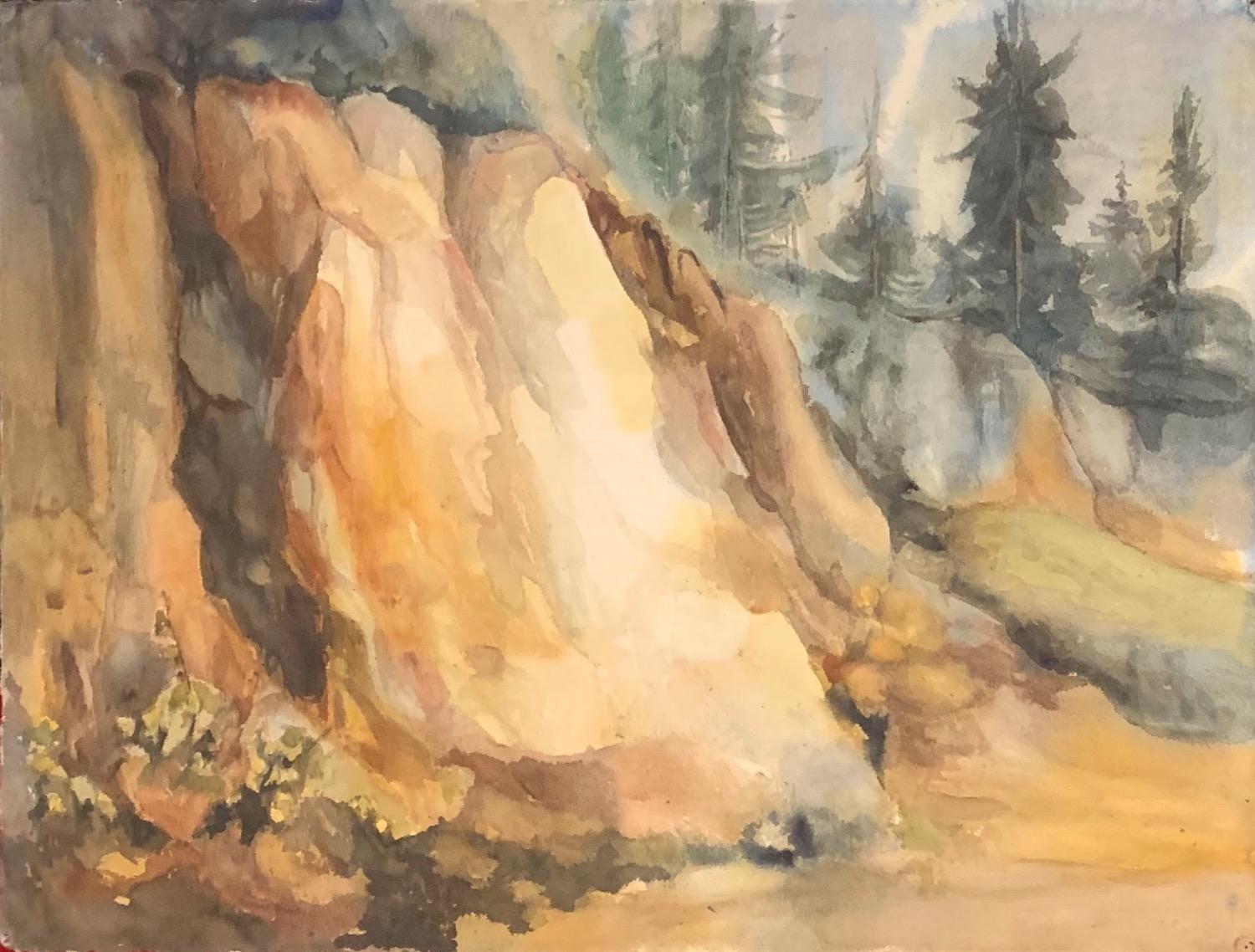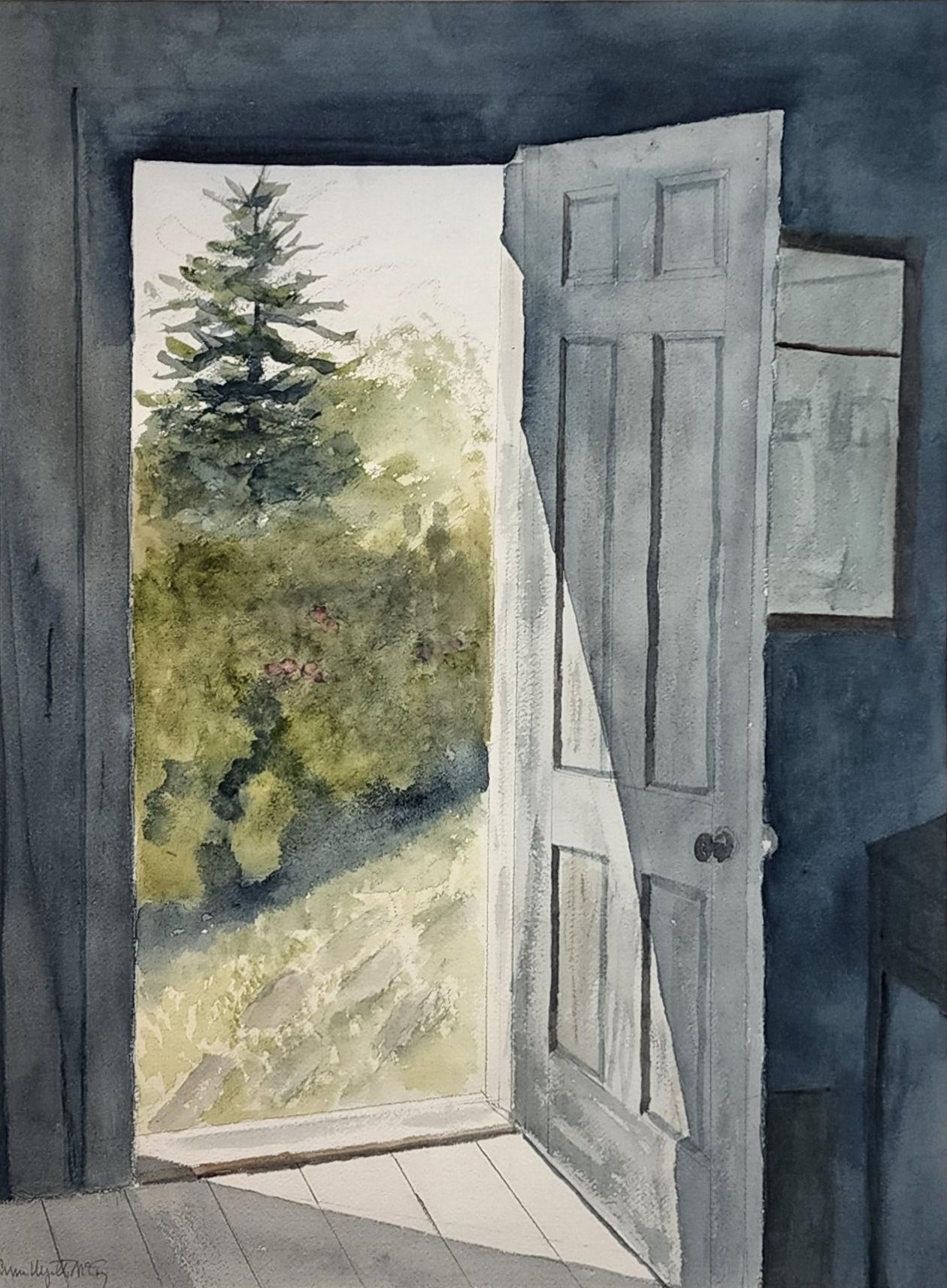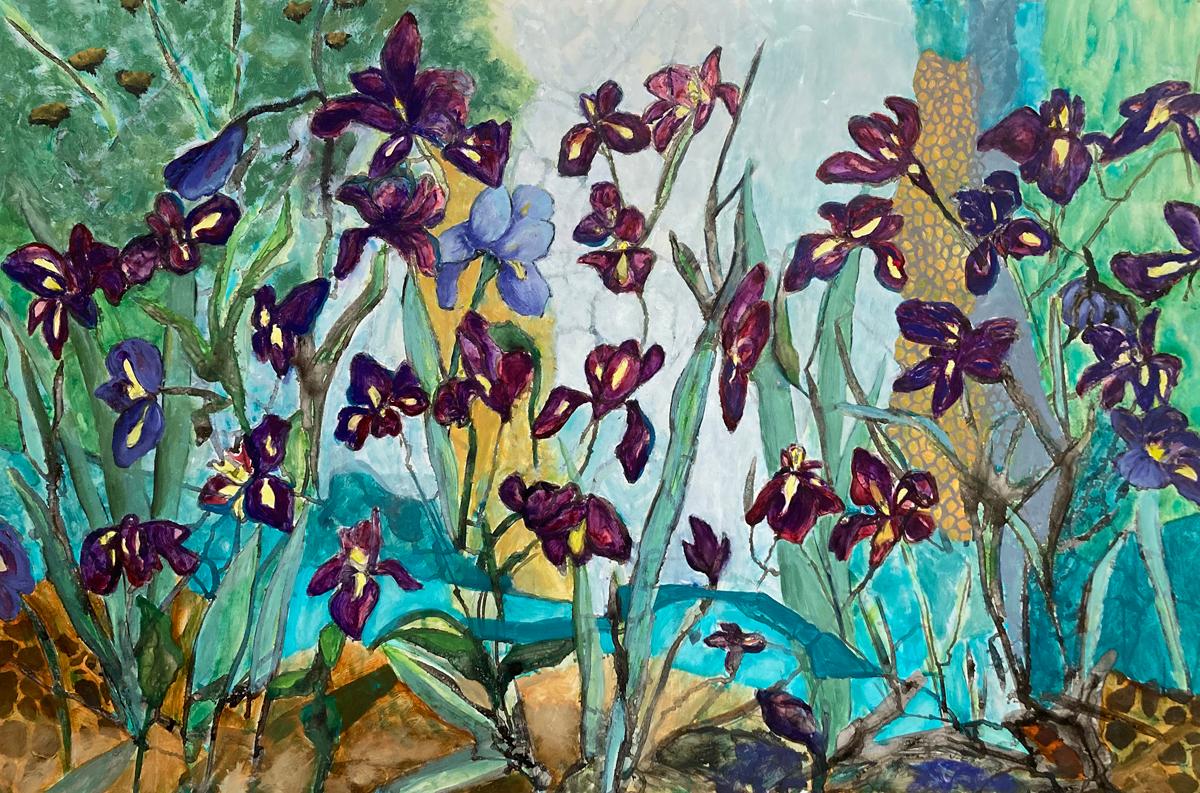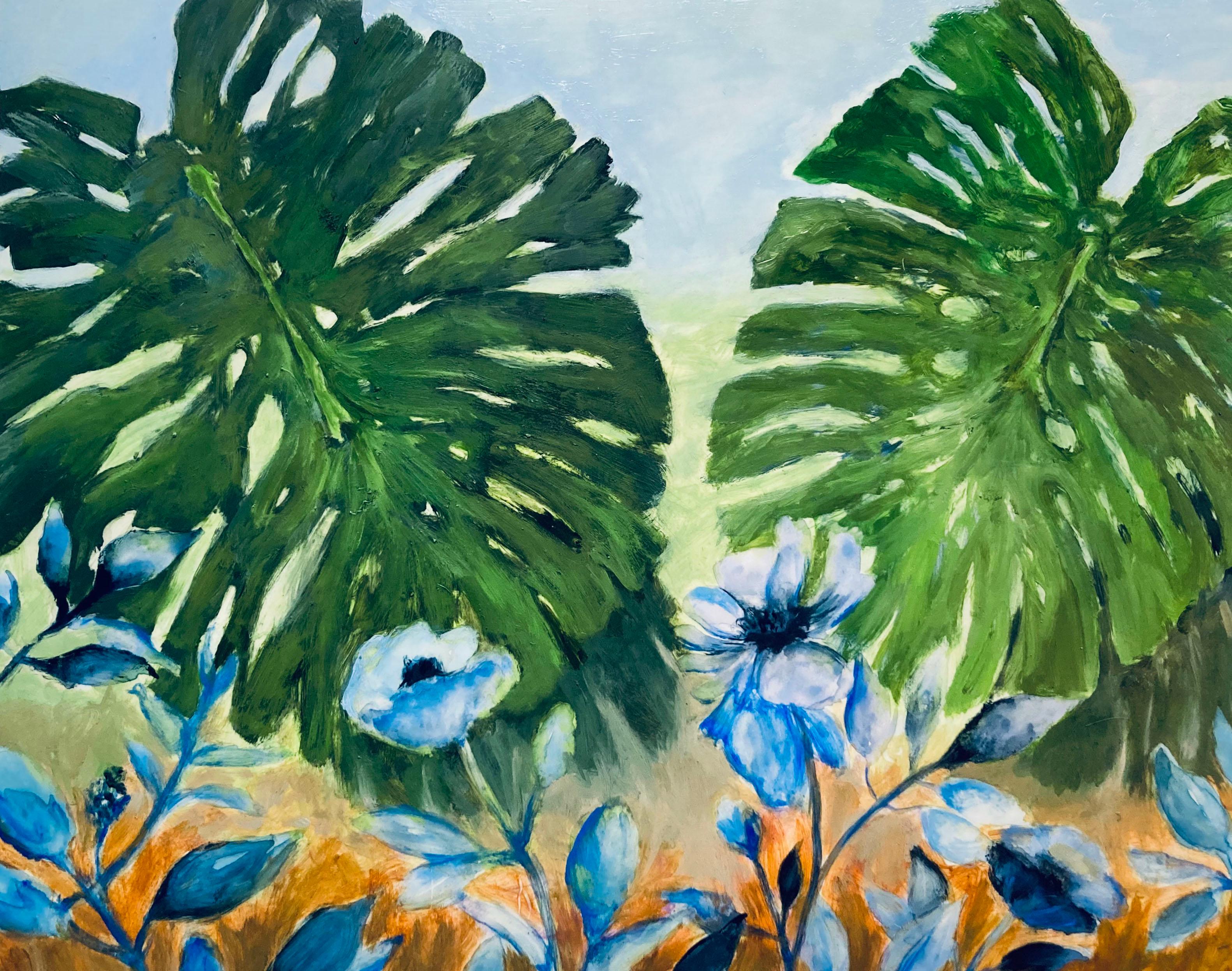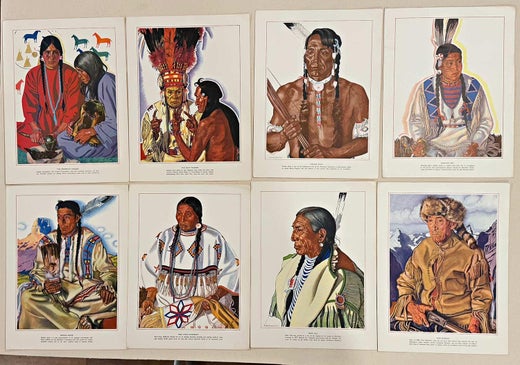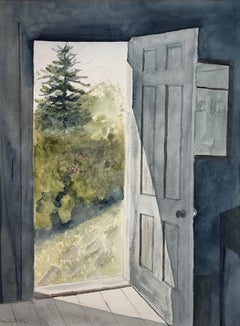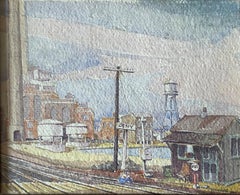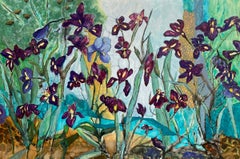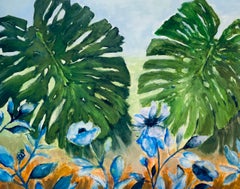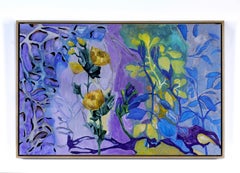Items Similar to "The Red Silo" Winold Reiss, Rural Regionalist Landscape, Sunny Day on Farm
Want more images or videos?
Request additional images or videos from the seller
1 of 8
Winold Reiss"The Red Silo" Winold Reiss, Rural Regionalist Landscape, Sunny Day on Farm
About the Item
Winold Reiss
The Red Silo
Signed lower left
Watercolor on paper
20 x 29 inches
Winold Reiss (1886-1953) was an artist and designer who emigrated to the United States from Germany in 1913. Probably best known as a portraitist, Reiss was a pioneer of modernism and well known for his brilliant work in graphic and interior design. A compassionate man who greatly respected all people as human beings, he believed that his art could help break down racial prejudices. Like his father Fritz Reiss (1857-1915), who was also an artist and who was his son's first teacher, Winold Reiss was artistically moved by diverse cultures. The elder Reiss focused on folk life in Germany while Winold drew substantial inspiration from a range of cultures, particularly Native American, Mexican, and African-American.
As did many young aspiring artists, Winold Reiss studied with the esteemed painter and teacher Franz von Stuck at the Royal Academy of Fine Arts in Munich, which was at that time a center of the decorative and fine-arts movement. It is not known whether Reiss met E. Martin Hennings (1886-1956) and Walter Ufer (1876-1936), who were also studying at the Royal Academy about that time and who later became members of the Taos Art Society. All of these artists' works depict elements taught by von Stuck.
Romantic visions of the West had spread across France and Germany through the tales of artists who had already visited the western portion of the United States. The popular novels of German author Karl May (1842-1912), whose stories of the American west filled young minds with travel and adventure tales, dealt with noble Indians and cowboys and offered moral lessons. Young Reiss was an avid reader of May's books.
It was often due to the American railroad companies' commissions that artists were enabled to travel in the West, paint the native peoples, and enjoy the magnificent landscapes. Some of them, like Ernest Blumenschein (1874-1960), Ernest Hennings and Walter Ufer, as well as many European artists who had settled in the East, went to the Southwest where they were supported through the commissions of the Atchison, Topeka & Santa Fe Railway Company's advertising campaign. Winold Reiss, however, headed to the Northwest. He chose Montana as his destination after hearing about the Blackfeet Indians and Glacier Park from his friend H.V. Kaltenborn, editor of the Brooklyn Eagle, who had traveled there earlier. After his first trip to Montana in January of 1920, Reiss was able to return to Glacier Park many times in a long-lasting collaboration with the Great Northern Railway. His works graced the calendars, menus, playing cards, and souvenirs of the Great Northern Railway for thirty years, thus reaching a wide audience.
Reiss's works remain well known today, in part because of the railroad calendars and souvenirs produced from his portraits. However, his work—like that of other great artists and illustrators such as Norman Rockwell—survives and flourishes not just as a result of the Great Northern's printed matter but because he captured a very recognizable and uniquely American theme. Reiss also expressed the great feeling for color and design that his native friends favored. He rendered his subjects in a way that conveyed honor, beauty, and dignity upon them, free of racial prejudice. His own unique style can be viewed as a synthesis of bold, colorful graphic design, skillful drawing, and fine art.
- Creator:Winold Reiss (1886-1953, American)
- Dimensions:Height: 30.5 in (77.47 cm)Width: 39.5 in (100.33 cm)
- Medium:
- Movement & Style:
- Period:
- Condition:
- Gallery Location:New York, NY
- Reference Number:1stDibs: LU1841212878072
Winold Reiss
Winold Reiss was a German-American muralist and illustrator who is best remembered for his portraits of the Blackfoot Indian tribe. His work was so revered by the tribe that when he died, his ashes were spread across sacred burial grounds.
About the Seller
5.0
Gold Seller
Premium sellers maintaining a 4.3+ rating and 24-hour response times
Established in 2022
1stDibs seller since 2022
98 sales on 1stDibs
Typical response time: <1 hour
- ShippingRetrieving quote...Shipping from: New York, NY
- Return Policy
Authenticity Guarantee
In the unlikely event there’s an issue with an item’s authenticity, contact us within 1 year for a full refund. DetailsMoney-Back Guarantee
If your item is not as described, is damaged in transit, or does not arrive, contact us within 7 days for a full refund. Details24-Hour Cancellation
You have a 24-hour grace period in which to reconsider your purchase, with no questions asked.Vetted Professional Sellers
Our world-class sellers must adhere to strict standards for service and quality, maintaining the integrity of our listings.Price-Match Guarantee
If you find that a seller listed the same item for a lower price elsewhere, we’ll match it.Trusted Global Delivery
Our best-in-class carrier network provides specialized shipping options worldwide, including custom delivery.More From This Seller
View All"Afternoon Sun, " Ann Wyeth McCoy, Interior and Landscape
Located in New York, NY
Ann Wyeth McCoy (1915 - 2005)
Afternoon Sun
Watercolor on paper
Sheet 24 x 18 inches
Signed lower left
Provenance:
Somerville Manning Gallery
Private ...
Category
20th Century American Realist Landscape Drawings and Watercolors
Materials
Paper, Watercolor
"Train Station, " Max Kuehne, Industrial City Scene, American Impressionism
By Max Kuehne
Located in New York, NY
Max Kuehne (1880 - 1968)
Train Station, circa 1910
Watercolor on paper
8 1/4 x 10 1/4 inches
Signed lower right
Provenance:
Private Collection, Illinois
Max Kuehne was born in Halle, Germany on November 7, 1880. During his adolescence the family immigrated to America and settled in Flushing, New York. As a young man, Max was active in rowing events, bicycle racing, swimming and sailing. After experimenting with various occupations, Kuehne decided to study art, which led him to William Merritt Chase's famous school in New York; he was trained by Chase himself, then by Kenneth Hayes Miller. Chase was at the peak of his career, and his portraits were especially in demand. Kuehne would have profited from Chase's invaluable lessons in technique, as well as his inspirational personality. Miller, only four years older than Kuehne, was another of the many artists to benefit from Chase's teachings. Even though Miller still would have been under the spell of Chase upon Kuehne's arrival, he was already experimenting with an aestheticism that went beyond Chase's realism and virtuosity of the brush. Later Miller developed a style dependent upon volumetric figures that recall Italian Renaissance prototypes.
Kuehne moved from Miller to Robert Henri in 1909. Rockwell Kent, who also studied under Chase, Miller, and Henri, expressed what he felt were their respective contributions: "As Chase had taught us to use our eyes, and Henri to enlist our hearts, Miller called on us to use our heads." (Rockwell Kent, It's Me O Lord: The Autobiography of Rockwell Kent. New York: Dodd, Mead and Co., 1955, p. 83). Henri prompted Kuehne to search out the unvarnished realities of urban living; a notable portion of Henri's stylistic formula was incorporated into his work.
Having received such a thorough foundation in art, Kuehne spent a year in Europe's major art museums to study techniques of the old masters. His son Richard named Ernest Lawson as one of Max Kuehne's European traveling companions. In 1911 Kuehne moved to New York where he maintained a studio and painted everyday scenes around him, using the rather Manet-like, dark palette of Henri.
A trip to Gloucester during the following summer engendered a brighter palette. In the words of Gallatin (1924, p. 60), during that summer Kuehne "executed some of his most successful pictures, paintings full of sunlight . . . revealing the fact that he was becoming a colorist of considerable distinction." Kuehne was away in England the year of the Armory Show (1913), where he worked on powerful, painterly seascapes on the rocky shores of Cornwall. Possibly inspired by Henri - who had discovered Madrid in 1900 then took classes there in 1906, 1908 and 1912 - Kuehne visited Spain in 1914; in all, he would spend three years there, maintaining a studio in Granada. He developed his own impressionism and a greater simplicity while in Spain, under the influence of the brilliant Mediterranean light. George Bellows convinced Kuehne to spend the summer of 1919 in Rockport, Maine (near Camden). The influence of Bellows was more than casual; he would have intensified Kuehne's commitment to paint life "in the raw" around him.
After another brief trip to Spain in 1920, Kuehne went to the other Rockport (Cape Ann, Massachusetts) where he was accepted as a member of the vigorous art colony, spearheaded by Aldro T. Hibbard. Rockport's picturesque ambiance fulfilled the needs of an artist-sailor: as a writer in the Gloucester Daily Times explained, "Max Kuehne came to Rockport to paint, but he stayed to sail." The 1920s was a boom decade for Cape Ann, as it was for the rest of the nation. Kuehne's studio in Rockport was formerly occupied by Jonas Lie.
Kuehne spent the summer of 1923 in Paris, where in July, André Breton started a brawl as the curtain went up on a play by his rival Tristan Tzara; the event signified the demise of the Dada movement. Kuehne could not relate to this avant-garde art but was apparently influenced by more traditional painters — the Fauves, Nabis, and painters such as Bonnard. Gallatin perceived a looser handling and more brilliant color in the pictures Kuehne brought back to the States in the fall. In 1926, Kuehne won the First Honorable Mention at the Carnegie Institute, and he re-exhibited there, for example, in 1937 (Before the Wind). Besides painting, Kuehne did sculpture, decorative screens, and furniture work with carved and gilded molding. In addition, he designed and carved his own frames, and John Taylor Adams encouraged Kuehne to execute etchings. Through his talents in all these media he was able to survive the Depression, and during the 1940s and 1950s these activities almost eclipsed his easel painting. In later years, Kuehne's landscapes and still-lifes show the influence of Cézanne and Bonnard, and his style changed radically.
Max Kuehne died in 1968. He exhibited his work at the National Academy of Design, the Art Institute of Chicago, the Carnegie Institute in Pittsburgh, the Memorial Art Gallery of the University of Rochester, and in various New York City galleries. Kuehne's works are in the following public collections: the Detroit Institute of Arts (Marine Headland), the Whitney Museum (Diamond Hill...
Category
1910s American Impressionist Landscape Drawings and Watercolors
Materials
Paper, Watercolor
"Tugboat at Dock, " Reginald Marsh, Modern WPA Industrial Ship
By Reginald Marsh
Located in New York, NY
Reginald Marsh
Tugboat at Dock, circa 1937
Signed lower right
Watercolor and pencil on paper
13 3/4 x 20 inches
Housed in a Lowy frame.
Provenance:
Sotheby'...
Category
1930s Modern Landscape Paintings
Materials
Paper, Watercolor, Pencil
"Gray Morning" James MacMaster, Scottish Seascape, Marine Ship Landscape
By James MacMaster
Located in New York, NY
James MacMaster
Gray Morning
Signed and titled lower left
Watercolor on paper
10 1/4 x 14 inches
Provenance:
Private Collection, New Jersey
Category
Late 19th Century Landscape Paintings
Materials
Paper, Watercolor
$540 Sale Price
70% Off
"Irvine Harbour" James MacMaster, Scottish Seascape, Marine Ship Painting
By James MacMaster
Located in New York, NY
James MacMaster
Irvine Harbour
Signed lower right
Watercolor on paper
10 1/4 x 14 inches
Provenance:
Private Collection, New Jersey
Category
Late 19th Century Landscape Paintings
Materials
Paper, Watercolor
$540 Sale Price
70% Off
"Gondolas at the Dock, Venice, Italy" Louis Wolchonok, Boats in the Harbor Scene
By Louis Wolchonok
Located in New York, NY
Louis Wolchonok (1898 - 1973)
Gondolas at the Dock, Venice, Italy, 1928
Watercolor on paper
Sight 18 x 23 1/2 inches
Signed and dated lower right
Louis Wolchonok was an author of ar...
Category
1920s Post-Impressionist Landscape Drawings and Watercolors
Materials
Paper, Watercolor
You May Also Like
1960s "Mountain Side" Watercolor Landscape California Gold Country Mid Century
Located in Arp, TX
Thelma Corbin Moody
AbEx Mountain Side
c. 1960's
Watercolor on Arches Paper
29.5" x 22", Unframed
Thelma Corbin Moody (1908-1986) of Modesto, CA....
Category
Late 20th Century American Realist Landscape Paintings
Materials
Paper, Watercolor
Irises Ink, Watercolor, Oil on Yupo paper 26” x 40” Framed 31 ¼” x 45 ¼”
Located in Houston, TX
Irises by Texas artist Julie England is an Ink and Watercolor, Oil on Yupo paper. The size of Irises is Image 26” x 40” Framed 31 ¼” x 45 ¼” Art is...
Category
2010s American Realist Landscape Paintings
Materials
Mixed Media, Oil, Watercolor
Cool Afternoon Oil Watercolor Yupo Paper 11″ x 14″ Image 16″ x 21 3/4″ Frame
Located in Houston, TX
Cool Afternoon by Texas artist Julie England is an Ink and Watercolor, Oil on Yupo paper. The size of Cool Afternoon is 11″ x 14″ Image
16″ x 21 3/4″...
Category
2010s American Realist Landscape Paintings
Materials
Oil, Watercolor
Yellow Poppies Ink Watercolor Oil on Yupo paper 26” x 40” Framed 31 ¼” x 45 ¼”
Located in Houston, TX
Yellow Poppies by Texas artist Julie England is an Ink and Watercolor, Oil on Yupo paper. The size of Yellow Poppies is Image 26” x 40” Framed 31 ¼” x 45 ¼” Yellow Poppies by Julie England is floated in a white 2” depth gallery frame with OP3 plexi glazing. Look for free shipping at checkout. Available for shipping on March 28.
Yellow Poppies was inspired by the idea of abstract art meets botanical illustration. Whether a mass of color blur or the focal point of a bloom like a botanical illustration, each is recording its environment and time. A meditative connection to the wild land comes with observation and ecological awareness. I paint natural, organic imagery with a focus on mark-making and use of material transparencies. My work includes vegetative and topological forms and gestures using color as a vehicle to convey energy from nature. I create images of imaginary environments inviting viewers to visit.
YELLOW POPPIES was included in the Natural Diversity Art...
Category
2010s American Realist Landscape Paintings
Materials
Mixed Media, Oil, Watercolor
Original Painting New Yorker Mag Cover proposal. Army Wedding American Scene WPA
By Antonio Petruccelli
Located in New York, NY
Original Painting New Yorker Mag Cover proposal. Army Wedding American Scene WPA
Antonio Petruccelli (1907 – 1994)
Army Wedding
New Yorker cover proposal, c. 1939
11 1/2 X 8 inches ...
Category
1930s American Realist Landscape Paintings
Materials
Gouache, Board
Original 70's Hand Painted Textile Design Gouache Green Shades on White Paper
Located in ALCOY/ALCOI, ES
We offer a small number of these original illustration designs by this design studio based in Alcoy (Spain), which could pair well or make group sets if buyers so desired. Designed t...
Category
1970s Modern Landscape Drawings and Watercolors
Materials
Paper, Gouache
Recently Viewed
View AllMore Ways To Browse
Rural America Painting
Vintage Sunnies
Great Northern Vintage
Regionalist Art
Red Cowboy
Montana Landscape Paintings
Norman West
Cowboy Drawing
Used Silo
French Noble Painting
Taos Indian Painting
Franz Stuck
Franz Von Stuck
Norman Rockwell Signed Prints
Silo Design
Native American Eagle Art
Souvenir H
American Eagle Folk Art
